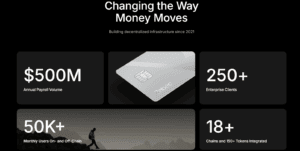Zebec Network wants to change how the world gets paid. The company says its blockchain-based payroll system can stream salaries in real time, allowing workers to get paid every second instead of waiting for biweekly paydays. On paper, it sounds revolutionary. In reality, the question remains — who’s actually using it?
A Bold Attempt to Fix an Old System
Zebec’s idea is simple: automate wage payments so they flow continuously rather than in delayed chunks. Built initially on the Solana blockchain, the system uses stablecoins such as USDC to eliminate volatility while taking advantage of blockchain’s speed.

For workers, the appeal is obvious. Freelancers, remote employees, and contractors could access earnings instantly instead of relying on slow, fee-heavy transfers. For companies, Zebec promises automated compliance, faster payroll reconciliation, and lower costs on cross-border payments. In theory, Zebec is not trying to reinvent finance — it’s trying to modernize something that hasn’t changed in decades: how salaries move.
Zebec Network’s Promising Numbers, But Few Proof Points
Zebec Network has shared optimistic metrics over the past year. Its official website reports handling around $500 million in annual payroll volume and serving more than 250 enterprise clients.

Those numbers sound impressive until we look closer. Zebec hasn’t released an audited report, and it hasn’t named any large corporations using its real-time payroll system at scale. Most of its reported clients come through its acquisitions of smaller, traditional payroll firms such as PayBridge and School Payroll Services, but there’s little data showing how many of those clients have actually switched to blockchain-based disbursements.
The broader context makes the gap even clearer. The U.S. payroll market alone exceeds $11 trillion annually. Compared to that, Zebec’s self-reported volume — while notable for a startup — represents a fraction of a fraction.
You May Also Like: Zebec Network (ZBCN) Targets Multi-Trillion-Dollar Payroll Sector — But Can It Succeed?
The Challenge: Technology Isn’t the Hard Part
Zebec Network’s technology works. It can stream payments by the second, manage stablecoin settlements, and integrate with wallets. The harder part is fitting that system into the real-world payroll framework, where employers must comply with tax rules, labour laws, and banking regulations across multiple countries.
In that sense, Zebec’s competitors have taken simpler routes. Sablier, which introduced token streaming on Ethereum back in 2019, uses the same principle of per-second payments — but it’s mainly used for crypto grants, token vesting, and DAO payrolls. It hasn’t had to face the regulatory complexity of large-scale corporate payroll.
Superfluid, another streaming-payments protocol, focuses on decentralized finance and subscription flows across multiple chains. Its model is flexible and widely adopted in crypto circles, but it too hasn’t broken into regulated payroll.
Zebec Network, by contrast, is trying to merge traditional payroll compliance with blockchain streaming — an ambitious goal that’s far harder to execute.
Additionally, the company’s native token, ZBCN, is designed to fuel transactions and governance on the network. In theory, more payroll usage should mean higher token demand. But that link hasn’t yet materialized in a verifiable way.
ZBCN’s rallies have so far coincided with announcements — token migrations, acquisitions, or partnerships — rather than clear spikes in payroll adoption. For the token to sustain value, its utility must extend beyond hype and into everyday transactions within Zebec’s ecosystem.
The Missing Proof of Zebec Network Adoption
For Zebec to achieve what it promises, adoption must move beyond startups and Web3 firms. Real disruption would mean traditional employers — manufacturers, tech giants, and service companies — processing salaries through its platform.
So far, no such evidence has been made public. Zebec Network’s website references “250+ enterprise clients,” but it hasn’t disclosed which of those use real-time stablecoin payroll. Nor has it published monthly transaction data beyond mid-2025.
This lack of transparency isn’t unusual for a young company, but it’s a major hurdle for credibility. In a sector known for hype cycles, measurable adoption is the only real proof that blockchain can change how people get paid.
To its credit, Zebec has gone further than many blockchain projects in tackling a real-world financial process. It has built infrastructure, secured regulatory partnerships, and acquired traditional payroll firms to bridge both worlds.
Compared with peers like Sablier and Superfluid, Zebec’s focus on regulated payroll rather than generic “streaming payments” gives it a potential edge. It’s targeting a much harder market — but one with massive upside if it works.
Still, the path forward depends on execution. Integrating blockchain into payroll means navigating compliance, maintaining stablecoin liquidity, and convincing conservative finance departments that continuous pay is worth the switch. That’s a tall order for any company, crypto-based or not.
